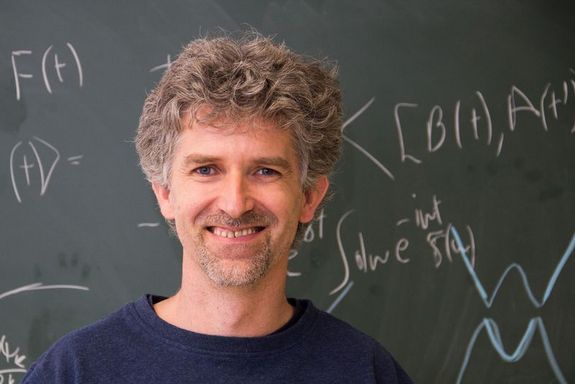Every day we can observe phase transitions – whenever soup is boiling in a pot or ice cubes are melting in a cocktail glass. But there are also quite different kinds of phase transitions, in which materials change their magnetic or electric properties. Those are the phase transitions Jan Kuneš is interested in. In 2014, he was awarded an ERC Consolidator Grant by the European Research Council (ERC), now he has moved from the Czech Academy of Sciences in Prague to the Institute of Solid State Physics at TU Wien (Vienna). His highly funded research project has been moved too, with his team soon to join him in Vienna. Kuneš and his group will further strengthen the field of material science at TU Wien, one of the university’s five main research focal areas.
Electrons and Holes
In a solid body, electrons can occupy different states. In a metal, an electron with high energy may be able to move freely, whereas another electron with less energy may be bound to one particular atom and cannot get away from it. If such an electron is removed, a so-called “hole” remains at this atom: at some point in the solid body, an electron is missing, which causes the region to become positively charged and allows other electrons from neighbouring atoms to move up. This way, the hole can start to migrate, much like electrons with high energies can migrate through the material.
A hole and a mobile electron can form a bond and move together – this is called an “exciton”. The concept of excitons - bonds between an electron with one particular energy and the absence of an electron at another energy level - may seem rather abstract. But mathematically, it can be described almost like a particle moving through the material.
Condensation of Excitons
“We are developing theoretical models which describe the behaviour of theses excitons”, says Jan Kuneš. He is particularly interested in the phenomenon of “excitonic condensation”. This can be compared to a Bose-Einstein-condensate, an exotic state of matter which is very interesting from a quantum physics point of view: atoms can form a Bose-Einstein-condensate at extremely low temperatures, when they all occupy a state of minimum energy. They become completely indistinguishable and condense into one large quantum object.
Something quite similar can happen to excitons. They, too, can condense into the same quantum state, exhibiting surprising new properties. For this, however, no extremely low temperatures are required. Even at high temperatures, excitonic condensation is possible.
“With these concepts we want to explain how materials change their magnetic properties under certain conditions, or how they switch from a superconducting to a non-superconducting state”, explains Kuneš. The concept of excitonic condensation has been discussed for years all over the world. But still, this field of research is still in its infancy. “People are looking for the best materials, in which these effects can be demonstrated and studied. Lanthanum cobalt oxide is a good candidate. We have already seen very interesting results, which agree well with our theoretical models.”
International Career
Jan Kuneš studied physics at Prague University, where he earned his PhD in 2002. After that he went to the University of California in Davis as a postdoc. In 2006, he moved back to Europe and continued his research at Augsburg University. In 2010 Jan Kuneš took a position in Prague, working as a senior scientist at the Czech Academy of Sciences. Since September 2016 he has been working in Vienna. In October, his ERC Consolidator Grant was officially moved to TU Wien.
